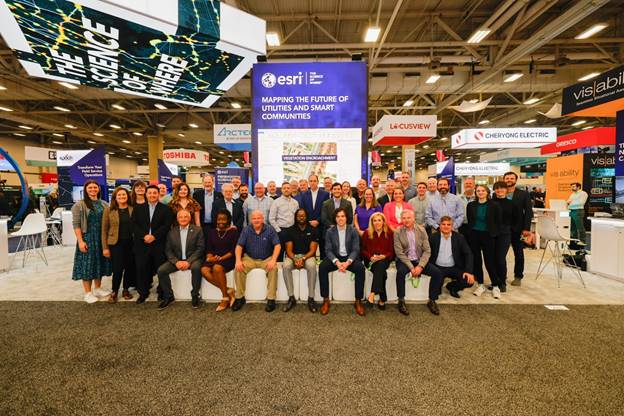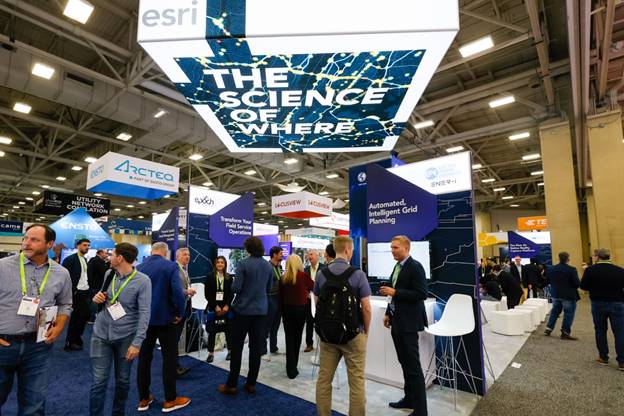It’s fair to say most exhibitors and attendees at DistribuTECH 2025 expected the dominant topic of conversation could be summarized in just two letters: AI.
The most impactful thought leadership re: artificial intelligence at this year’s conference leveraged real-world examples. That’s why Esri, which has made a tradition of spotlighting its numerous technology partners who integrate its industry-leading GIS tool at DistribuTECH, made such a splash.
We spoke with Pat Hohl, Esri’s Director of Electric Industry Solutions, Energy Central Expert, and frequent Community Contributor, to better understand Esri’s pioneering geospatial information systems (GIS) for utilities.
The big picture? “You should never have to start with a blank piece of paper,” Hohl said.
Making AI Work for Utilities: Practical Applications
To turn Esri’s focus on AI integrations more practical and tangible, Hohl pointed to real-world examples of AI already at work in utilities. For example: image analysis. GIS tools are regularly paired with vast troves of imagery, captured by satellite, drones, lineworkers, and more. This photographic evidence of the state of the grid and its components has been among the most valuable evolutions in asset management in the past decade, but dealing with such large amounts of human-processed data creates new backlogs of work and bottlenecks.
AI can play a key role here—analyzing images quicker and more accurately than humans to identify problems: vegetation conflicts, broken poles, damaged components, or other needs for action. But a lightbulb moment came for Hohl during one partner’s presentation at the Esri booth during DistribuTECH when an audience member asked if these AI tools could be successfully tasked with identifying if a photo showed an electric power pole had no issues with it. The presenter ran an ad-hoc test live in front of the audience with the loaded AI tool, quickly finding that the program was in fact able to confirm an image contained no problems of note.
“Finding no problems in a photo?” Hohl asked. “That’s potentially more amazing than finding the problems!” He explained the use case where a customer in the field submits a photo of a perceived problem with a pole, say a downed wire. Using AI, that image could be quickly processed to identify that the visible wire was actually a non-electrified, non-critical telephone wire. Given that information, the utility would know that the issue can wait until an optimal time to send a crew out rather than wake a lineworker in the middle of the night to review and resolve a non-issue.
Navigating Change Management: The Evolving Workforce
To meet this increasingly digital moment, the utility industry is undergoing a significant shift in workforce. This evolution, according to Hohl, is driven by generational change and the integration of advanced technologies like AI and GIS.
Reluctance from more seasoned workers accustomed to legacy systems has often slowed the pace of innovation and adoption, but as these workers retire, a new generation of digital-native employees is stepping in. As Hohl put it, “The digital native workforce expects to do everything in an automated, instant fashion via technology. They look at a paper form or map and think, ‘What are we doing here?'”
The demand for these modern tools has also created fresh opportunities to overcome long-standing barriers. For example, advanced GIS systems now offer dynamic dashboards and intuitive applications that streamline processes in real time—whether it’s pole inspections, outage management, or customer engagement. Utilities are finding that catering to this workforce’s technological expectations not only enhances operational efficiency but also fosters a more agile and proactive culture.

The Future of GIS: Building Smarter Grids
Hohl said that one-third of Esri’s revenue goes back to innovation. His team is committed to transitioning from historic geometric network models to more modern network information management to support the future grid. Doing so requires 1) focus to ensure data integrity creates a solid foundation for grid modeling 2) buy-in from utilities to break down siloes trapping information and blocking communication and 3) a culture willing to try new approaches. “The grid is no longer ‘set it and forget it,’” Hohl said. “AI and GIS are here to assist, but they can’t do everything. You need to take the next step.
All week, Energy Central is publishing our series of conversations from DistribuTECH 2025. You can see them all as they go live at this landing page.
Other published interviews:












